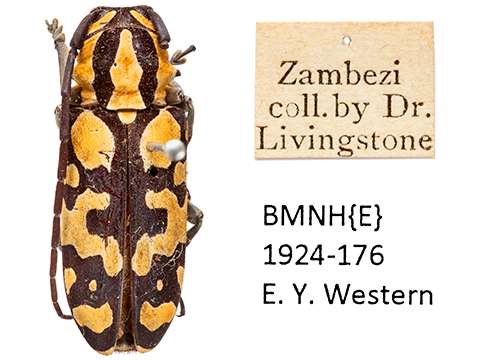Livingstone beetle specimens found after 150 years

Dr David Livingstone's only known beetle specimens have been discovered at the Museum - 150 years after he brought them back from Africa.
The 20 specimens date back to Dr Livingstone's expedition along Africa's Zambezi River, which ran from 1858 to 1864.
Experts were unaware that the renowned British explorer had collected beetles until now.
The specimens were unearthed by curators cataloguing and photographing the Museum's collection for its online database. They came across an unusual box and when they opened it they discovered that Dr Livingstone's name and the name of the Zambezi expedition were written on the specimens' labels.
The insects were donated to the Museum by a private collector, Edward Young Western, in 1924. He is thought to have bought them directly from a member of the Zambezi expedition. In the days before digital records, they got lost among the Museum's 10 million beetle specimens and sat unnoticed for 90 years.
An incredibly rare find
Museum beetle curator Max Barclay, who made the discovery, said it was a complete surprise and one of great historical and scientific importance.
'We have 22,000 drawers of beetles and every drawer is like a treasure chest waiting to be opened. You can never imagine what you will find inside,' he said.
'Historically, it is very exciting that these specimens have been preserved. No biographers mention Dr Livingstone collecting beetles - it is an aspect of the well-known explorer that was previously unknown.'
There are twelve different beetle species in the box including the giant predatory ground beetle, Termophilum alternatum, the variegated golden longhorn beetle, Tragocephala variegata, and the flightless spiny longhorn beetle, Phantasis avernica.
Indicators of environmental change
Barclay said that the specimens are already shedding light on the effects of environmental change in the Zambezi region.
Museum entomologist Hitoshi Takano recently led a number of expeditions retracing Dr Livingstone's footsteps across Africa's interior. During his travels he came across many of the same beetle species that Dr Livingstone spotted 150 years before.
Barclay said: 'The fact that most of the same species can still be found in Zambezi today means that the environments in the area might have changed less than we expected. Or, against all odds, many species from Dr Livingstone's day still remain despite 150 years of habitat destruction and deforestation.'
But one species of beetle collected from Zambezi by Dr Livingstone was not found in the region during Takano's expeditions. This could be evidence of the effect of environmental changes, said Barclay:
'It is possible that this species has declined or been lost from the region. Insects are often like the canary in the mine - their decline warns us about environmental changes that we may not have easily noticed.'
Old specimens, new insights
Barclay said that before digital records were introduced knowledge was often lost between generations, but Dr Livingstone's beetles will be valuable sources of information for scientists for years to come.
'We can learn so much from them. Old specimens are a little bit like a fossil record of the environment at a past time.'
'We are discovering things that our great-grandparents' generation may have known, but the information was never passed down. Nowadays we record this information on databases and online, so it will be preserved for future generations.'
The specimens will be displayed for one night only at Science Uncovered, the Museum's annual science festival, on 26 September 2014.
Dr Livingstone, a Scottish missionary and one of the first European explorers of Africa, died in Zambia in 1873, aged 60.
Provided by Natural History Museum





















